knots & links
One of the most popular knots for tying terminal tackle to fluorocarbon or monofilament line in the U.S.A. is the Polomar knot, which is rarely used in Europe, probably because it is so simple.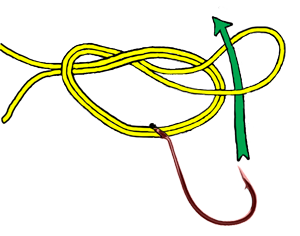
1. The line is threaded through the eye of the hook and then threaded back out to form a large loop.
2.
Holding the main line and tag end, the loop is used to tie a granny knot.
3. The hook is then pushed through the loop and pulled tight.
The Polomar knot works really good for the Quantum Exo line and is also used on a dropshot rig to make the hook stand out.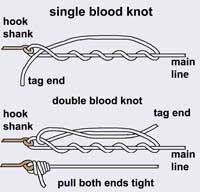
With monofilament line a double blood knot can be used to attach swivels or hooks. Wet the knot before pulling both ends tight and then snip the tag end quite close to the knot. This is probably the most common knot used by anglers. It is advisable to use a double blood knot when fishing with light line.
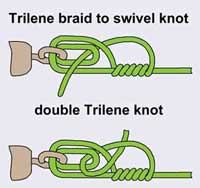
To tie hooks or swivels to braided line it is advisable to use a double Trilene® knot, which is virtually the same as a blood knot, the only difference being the braid line is threaded through the eye of the swivel twice before threading through both loops 5 times. After pulling tight trim off to leave a 5mm tag end.
Power Pro recommends using a single Uni knot for terminal tackle, which 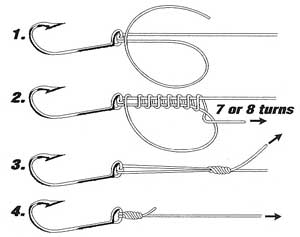 although it is difficult to see, starts in the same manner as the Trilene® knot by double threading it through the eye of the hook or swivel, then creating another loop over the main line and threading the tag end through that 7 or 8 times before pulling it tight.
although it is difficult to see, starts in the same manner as the Trilene® knot by double threading it through the eye of the hook or swivel, then creating another loop over the main line and threading the tag end through that 7 or 8 times before pulling it tight.
It seems that braided line must be threaded through the eye of the hook or swivel twice to make sure it does not slip.
To 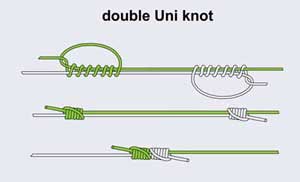 tie a short fluorocarbon leader or hook rubbing line to the end of a braid main line it is preferable to use the same strength leader as the main line or slightly lighter, which is joined to the main line with a double Uni knot.
tie a short fluorocarbon leader or hook rubbing line to the end of a braid main line it is preferable to use the same strength leader as the main line or slightly lighter, which is joined to the main line with a double Uni knot.
Also use this knot to join the ends of braided line back together if a wind knot has been cut out.
There are a variety of clips or snap links that are used to attach the lure to the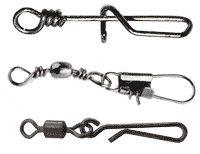 leader, some with swivels, some not. There are those who advocate using swivel as it helps eliminate wind knots.
leader, some with swivels, some not. There are those who advocate using swivel as it helps eliminate wind knots.
The advantage of snap links is that it easily allows you to quickly change a lure with the least possible hassle.
A lure rubbing line or leader can be as long or as short as you like, some have it as long as 2metres whilst others have it as short as 0.5metres. Regardless of its length, most tie a clip to the end of the leader so that lures can easily be changed, whilst others like to disregard swivels completely and tie the lure directly onto the leader—it is down to individual choice.
traditional lure assembly
Packs of small solid and hollow paddle tail lures without hooks are now  coming in from Japan that can be set up in the old school way, but even this has been updated; now the lead weight ships with integral swivels. The 2m-fluorocarbon hook trace is tied to one end of a Grauvell Titan lead weight with the main line tied to the other.
coming in from Japan that can be set up in the old school way, but even this has been updated; now the lead weight ships with integral swivels. The 2m-fluorocarbon hook trace is tied to one end of a Grauvell Titan lead weight with the main line tied to the other.
The advantages of this set up are, the long trace allows the lure to be influenced by the movement of the water. and small lures or flies can easily be cast. To use this setup with small light lures requires more skill than using weighted lures, but is easily learned with a little practice.

With this setup, just before the lure hits the water after casting, the bale arm is closed to stop the line, this allows the lure to overtake the weight just as it hits the water. This rig is very popular with many who fish the estuary at Teignmouth.
retrieving the lure
To get the most out of a paddle tail lure it must be retrieved fast enough to make the tail work and maintain a constant depth. When retrieving the lure at a constant speed—hold the rod tip up to make the lure swim shallow—hold the rod tip down and the lure will swim deeper.
The faster the lure is retrieved, the closer to the surface it will swim, the slower the lure is retrieved, the deeper it will swim. Finally, light lures are retrieved slower than heavy lures—that's about all there is to it.
The initial problem when using any lure is learning how fast to retrieve it and with paddle-tail lures it could not be simpler. First of all—it is difficult to retrieve a paddle-tail lure faster than a Bass can take it, so begin with quite a fast retrieve to feel the full weight of the working lure. Then progressively slow the retrieve until you reach a speed that is both slow enough to be comfortable but fast enough to feel the weight of the lure working in mid water; that is the sweet spot you are looking for.
As you become more confident you can vary the speed and depth of the lure by lifting and lowering the rod tip or by moving the rod from side to side. Either way will make the lure dart sideways or an up and down motion, giving the lure a more realistic action.
concept angling - dropshot
Very small plastic worms, paddle tails and split tail lures are designed to be presented Dropshot style on a small hook. Although the majority of these lures are aimed at the huge American market, this method of angling is becoming ever more popular with pier anglers as it is a really simple way of presenting the lure close to the bottom.
Using this method of angling from the pier, after gently casting the rig out, when the the weight settles on the sea bed, the rod tip is lowered and lifted to give the lure action. After a few jerks a small amount of line is retrieved and the process begins over.
What makes makes this different from a simple paternoster rig is the hook 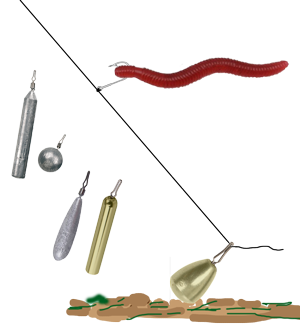 tied directly to the mainline with the hook point upmost with a Polomar knot. The sinker weight is attached to the line with an integral locking clip that eliminates the need for it to be tied, allowing the depth of the lure to be rapidly adjusted. To the left of the rig I have illustrated a variety of Dropshot weights, the lighter brass weights are designed for freshwater angling whilst the heavier lead weights are used for sea angling.
tied directly to the mainline with the hook point upmost with a Polomar knot. The sinker weight is attached to the line with an integral locking clip that eliminates the need for it to be tied, allowing the depth of the lure to be rapidly adjusted. To the left of the rig I have illustrated a variety of Dropshot weights, the lighter brass weights are designed for freshwater angling whilst the heavier lead weights are used for sea angling.
Dropshot sinkers are only suitable for use with light monofilament line and will not stand hard casting.
For more information this and something really different about HRF and LRF, see Concept Angling on the links page.

